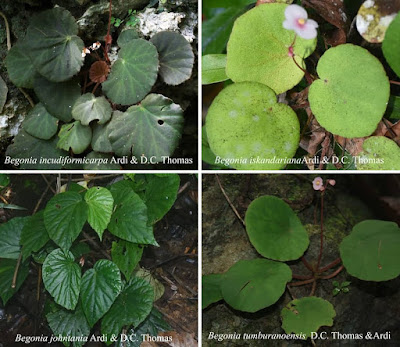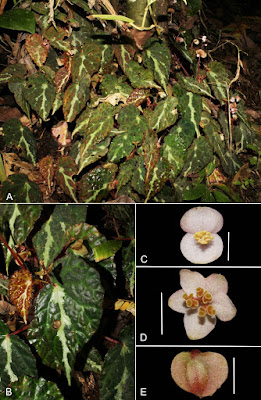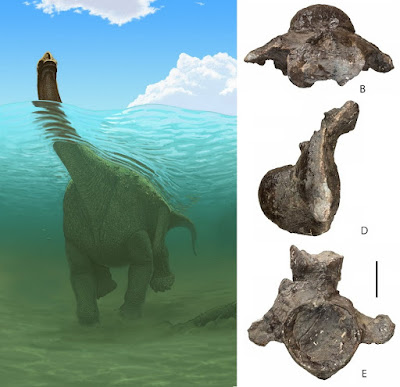[Most Recent Entries] [Calendar View]
Saturday, December 8th, 2018
| Time | Event | ||||
| 8:50a | [Botany • 2018] A Synopsis of Begonia (Begoniaceae) of Southeastern Sulawesi including Four New Species; Begonia incudiformicarpa, B. iskandariana, B. johntania & B. tumburanoensis
Abstract Material acquired on a recent expedition to Southeastern Sulawesi, Indonesia, presents an opportunity to reassess and provide an overview of the Begonia flora of the region. Eleven species are recognized including four new species described and illustrated here: Begonia incudiformicarpa, B. iskandariana, and B. tumburanoensis (all in Begonia section Jackia); and B. johntania (Begonia section Petermannia). The former three species are the first confirmed records of section Jackia on Sulawesi substantially extending the known eastern range limit of this section. In addition, an illustration and a lectotypification of Begonia flacca are presented, and an identification key to Begonia species in Southeastern Sulawesi is provided. Keywords: Jackia, Petermannia, Platycentrum, Sulawesi Tenggara, Sultra, taxonomy, Begonia, Eudicots Wisnu H. Ardi, Tatik Chikmawati, Joko R. Witono and Daniel C. Thomas. 2018. A Synopsis of Begonia (Begoniaceae) of Southeastern Sulawesi including Four New Species. Phytotaxa. 381(1); 27–50. DOI: 10.11646/phytotaxa.381.1.7 | ||||
| 9:14a | [Botany • 2018] Taxonomic Notes on the Philippine Endemic Begonia colorata (Begoniaceae, section Petermannia)
Abstract Recent exploration in Mt. Ararat, Bayugan City, Agusan del Sur resulted in a collection initially identified as Begonia bolsteri, a poorly known Philippine endemic species first described over a century ago. Examination of the types of this species and the type of B. colorata led us to the conclusion that these names represent the same taxon, and we place them in synonymy under the earlier name of B. colorata and designate lectotypes for both names. In this paper, we provide a comprehensive description for the species and photographs to facilitate easy identification. Keywords: Agusan del Sur, Mindanao, taxonomy, tropical botany, typification
Begonia colorata Warburg (1904: 51). Type:—PHILIPPINES. Mindanao, Sibulan, July 1888, Warburg 14633 (lectotype B[B100238148!] designated here) Fig. 1. = Begonia bolsteri Merr. (1911: 387) syn. nov. Type:—PHILIPPINES. Mindanao, Province of Surigao, in damp shaded places, elev. 75 m, April 1906, Bolster 310 (lectotype B[100238109!], designated here; isolectotypes K[000761015!], PNH [112576-image!], US [00115258-image!]). Distribution:— PHILIPPINES. Biliran, Mindanao, Luzon, Visayas (Pelser et al. 2011; Hughes et al. 2015–), Fig. 2. Ecology:— Growing in damp areas under a semi-open to closed canopy in primary and secondary forest at an elevation of 75–700 m asl. Mark Arcebal K. Naive, Grecebio Jonathan D. Alejandro and Mark Hughes. 2018. Taxonomic Notes on the Philippine Endemic Begonia colorata (Begoniaceae, section Petermannia). Phytotaxa. 381(1); 127–131. DOI: 10.11646/phytotaxa.381.1.16 | ||||
| 10:13a | [Botany • 2018] Centenaria rupacquiana • A New Genus of Compositae (Eupatorieae, Piqueriinae) from Peru, named Centenaria to honour the 100th Anniversary of the Natural History Museum of the National University Mayor of San Marcos
Abstract A little herb from central Peru is recognised as a new species of a new genus. Centenaria rupacquiana belongs to the tribe Eupatorieae, subtribe Piqueriinae. It has asymmetrical corollas with two inner lobes smaller, a flat and epaleaceous receptacle and the presence of pappus. In Peru, Centenaria is related to the genera Ferreyrella and Ellenbergia, but Ferreyrella is different by having no pappus and a paleate receptacle; and on the other hand, Ellenbergia is different by having symmetrical corollas. Keywords: Asteraceae, Ellenbergia, Eupatorieae, Ferreyrella, Rupac Centenaria P.Gonzáles, A.Cano & H.Rob., gen. nov. Description: Small, erect, annual herbs, to 30 cm tall. Leaves opposite, blade ovate to broadly elliptical, coarsely to finely serrate. Inflorescence a diffuse corymbose cyme. Phyllaries 5, distant, biseriate, subequal to equal, persistent, oblong-elliptical to obovate-elliptical, with shortly apiculate apices; receptacle flat, foveolate, glabrous, epaleaceous. Florets 7–14; corollas asymmetrical with the two inner lobes smaller, white, with distinct short constricted basal tube bearing glandular or eglandular hairs; throat short and broad-campanulate; lobes as long as wide or outer lobes of peripheral florets longer, short-papillose on inner surface and margins; lower part of filament glabrous; anther collars rather short; style base not enlarged, glabrous; arms rather short-clavate, densely short-papillose; papillae larger and less dense below clavate tip. Achenes prismatic, 5-ribbed, ribs setuliferous, narrowed and setuliferous above carpopodium; carpopodium inconspicuously, short-cylindrical; pappus 5 long, lanceolate squamellae, densely scabrid on margins, nearly smooth on outer surface, smooth on inner surface. Centenaria rupacquiana P.Gonzáles, A.Cano & H.Rob., sp. nov. Diagnosis: A little herb characterised by its asymmetrical corollas with two small inner lobes, flat and epaleaceous receptacle and presence of pappus. Type: Peru. Dept. Lima: prov. Huaral, Dist. Atavillos Bajo, NE of Pampas, road to Rupac, archaeological monument pre Inca, slopes with loamy clay soil, scrubland, ..., 3033–3509 m a.s.l., 15 Apr 2018, (fl,fr), A. Cano, P. Gonzáles, E. Huamán, S. Riva & S. Rivera 22682 (holotype: USM-3070016!, isotypes: MO!, MOL!, US-3730645!, USM!). Distribution: Known only from the type locality in Rupac, northeast from Lima Department. Ecology: Terrestrial plant growing on open area amongst shrubs, in the western Cordillera shrubland, between 3000–3500 m a.s.l. Co-occurring species include Paracalia jungioides (Hook. & Arn.) Cuatrec., Heliopsis buphthalmoides (Jacq.) Dunal, Dasyphyllum ferox (Wedd.) Cabrera and Vulpia megalura (Nutt.) Rydb. Flowering and fruiting between April and May. Etymology: The genus is dedicated to the centennial of the institutional foundation of the Natural History Museum of National University Mayor of San Marcos (1918–2018), for their hard work on the research, conservation, preservation and diffusion of the biodiversity of the country. All these actions are steadily increasing our knowledge of the flora and fauna of our native land. The specific epithet refers to Rupac, a small village with archaeological remains from the Atavillos culture, where the only two populations of this species are known from this place. Paúl Gonzáles, Asunción Cano and Harold Robinson. 2018. A New Genus of Compositae (Eupatorieae, Piqueriinae) from Peru, named Centenaria to honour the 100th Anniversary of the Natural History Museum of the National University Mayor of San Marcos. PhytoKeys. 113: 69-77. DOI: 10.3897/phytokeys.113.28242 Resumen: Una pequeña hierba del centro del Perú es reconocida como una especie nueva en un nuevo género. Centenaria rupacquiana es miembro de la tribu Eupatorieae subtribu Piqueriinae. Tiene corolas asimétricas con dos lóbulos internos más pequeños, receptáculo plano y sin palea, y presencia de papus. En Perú, Centenaria está relacionada a los géneros Ferreyrella y Ellenbergia, Pero Ferreyrella se diferencia por carecer de papus y presentar un receptáculo con paleas; por otro lado, Ellenbergia se diferencia por sus corolas simétricas. | ||||
| 3:12p | [Paleontology • 2018] Volgatitan simbirskiensis • The Oldest Titanosaurian Sauropod of the Northern Hemisphere
ABSTRACT Volgatitan simbirskiensis, gen. et sp. nov., is described based on a series of anterior and middle caudal vertebrae from a single individual discovered in the Lower Cretaceous (upper Hauterivian, Speetoniceras versicolor ammonite Zone) marine deposits at Slantsevy Rudnik vertebrate locality near Ulyanovsk City, Russia. The new taxon is characterized by strongly procoelous anterior and middle caudal vertebrae, a long centrum of the first caudal vertebra, a strong ventral ridge in the anterior and middle caudal vertebrae, a neural arch positioned at the anterior half of the centrum, hyposphene-hypantrum articulation in the anterior caudal vertebrae, and somphospondylous bone texture. Phylogenetic analysis places the new taxon as a lithostrotian titanosaur, a basal member of the lineage leading to the Lognkosauria. This lineage previously contained only South American taxa with body mass reaching 60–70 tons. Volgatitan gen. nov. is the first European and the geologically oldest representative of this lineage. Its body mass is estimated as 17.3 tons. Discovery of Volgatitan gen. nov. suggests that the lithostrotian lineage leading to the Lognkosauria had a wider distribution in the Early Cretaceous and became extinct everywhere except South America by the end of the Early Cretaceous. KEYWORDS: Dinosauria, Sauropoda, Titanosauriformes, Titanosauria, Lithostrotia, Early Cretaceous, Eastern Europe, Russia
Alexander Averianov and Vladimir Efimov. 2018. The Oldest Titanosaurian Sauropod of the Northern Hemisphere. Biological Communications. 63(3), 145–162. DOI: 10.21638/spbu03.2018.301 Scientists from St Petersburg and Ulyanovsk have described a new giant dinosaur english.spbu.ru/news/2482-scientists-fro "Titanosaur" by Olorotitan deviantart.com/olorotitan/art/Titanosaur-211260962 |
| << Previous Day |
2018/12/08 [Calendar] |
Next Day >> |













